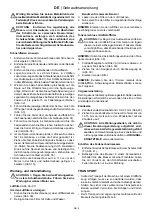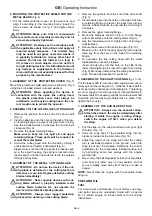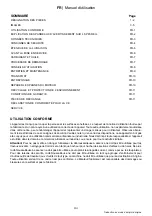
GB-7
GB
|
Operating Instruction
Emergency stop: If it should be necessary to
stop the tool immediately push the “STOP”
button.
OPERATING ADVICE
-
If you are not familiar with the trimmer train the handling
of the device with the engine not running (AUS / STOP).
-
Always check the territory; solid objects as metal parts,
bottles, stones etc. may be hurled away and cause serious
injuries or permanently damage the device. Should you
touch a solid object with the trimmer shut the engine off
immediately (AUS / OFF) and examine the trimmer for
possibly existing damages. Do not use the device when
it is damaged or shows sign of defects.
- Always trim and cut with the engine running in the higher
speed range. Do not let the engine run at low speed at
the beginning of or during the trimming.
- Use the device for its provided purpose only, i.e., trimming
and cutting grass and weeds.
- Never hold the cutting head higher than your knees during
operation.
- If working on a slope always stand with the cutting unit
above you. Only work on sloping sites if you stand on
firm ground.
TRIMMING
The trimmer – properly equipped with protection cover and
cutting head – trims high grass, brushwood and weeds
at places that are difficult to access along fences, walls,
foundations and around tree trunks. The trimmer may also
be used for cutting down to the ground (e.g., clean-out
works in the garden and in broken, thickly covered areas).
NOTE:
When trimming near foundations, stone walls
etc., even extreme care cannot avoid an increased
wear of the cutting cord.
TRIMMING / MOWING
Swing the trimmer in sickle-like movements from side to
side. Always hold the cutting head parallel to the ground.
Examine the territory and determine the desired cutting
height. Lead and hold the cutting head in the desired height
to achieve an even cutting result (Fig. 23).
Low trimming
Lead the trimmer straight with a slight angle in forward
direction so that it moves just over the ground. Always trim
away from your body, never lead it towards the operator
(Fig. 24).
TRIMMING AT FENCES AND FOUNDATIONS
To trim at fences, posts, stone walls and foundations lead
the device slowly and carefully without letting the cutting
cord touch any obstacles. If the cutting tool encounters any
solid obstacle (stone, wall, log etc.) there is the danger of
a kickback and higher wear and tear of the cutting cord.
TRIMMING AROUND TREE TRUNKS
(FIg. 27)
Walk round the tree from left to right, approaching the
trunks slowly so as not to strike the tree with the line and
keeping the cutting line head tilted forward slightly.
Remember that the nylon line could lop or damage small
ATTENTION:
Do never use pure fuel without oil.
This will damage the engine and you will loose your
warranty rights. Do not use fuel mixtures that have
been stored for more than 90 days.
ATTENTION:
Only use high-quality 2-stroke mixing
oil for air-cooled engines, mixture ratio 40:1.
FUEL MIXTURE
Mix the fuel with 2-stroke oil in an approved container.
Refer to the mixing table to find the required mixture ratio
for the fuel and oil. Shake the container to properly mix
the two fluids.
Mixing table for fuel mixture
Petrol
2-stroke oil / 40:1
1 litre
25 ml
5 litres
125 ml
ATTENTION: If you should you use an improper
mixture ratio you will loose your warranty rights.
STARTING THE ENGINE
COLD START
In order not to overtax the engine when starting it, cut the
trimmer cord to 17 cm (Fig. 15).
1. Put the ignition switch in position ‘I’ (Fig. 16).
2. Slide the choke to position ‘Start’
(Fig. 17).
3. Push the fuel pump (16) 6 times (Fig. 18).
4. To push the throttle lever (9) it is necessary to first
push the locking lever (11).
Pull throttle lever and
block it in half-gas position using the locking button
(12); let go of the throttle lever
(fig. 19)
.
5. Firmly hold the device by the handle. Pull the starter
rope 2-3 times (Fig. 20); to start the motor it is re-
quired to evenly, quickly pull the rope.
6. Slide the choke to ‘RUN’
position (Fig. 21).
Pull
starter rope until the engine starts.
7.
As soon as the engine starts running shortly open the
throttle to unlock the throttle lever from its half-gas
position.
8. Let the motor idle for about 10 seconds to warm up.
9. If the motor does not start repeat the steps 1-8.
NOTE:
If the engine should not start after several tries
proceed as described in the chapter ‘Trouble-shooting’.
NOTE:
Always pull out the starter rope straight. If you
do not pull straight the rope will chafe at the eyelet.
This chafe will cause the rope to fan out and thus to
a higher wear and tear. Always hold the starter rope
handle when the rope is pulled back. Do not let the
rope flick back when it is pulled out. This could lead to
a hook-up of the rope and/or a damage to the starter
housing.
STARTING WARM ENGINE
DO NOT USE THE CHOKE!
Complete steps 1, 4, 6, and 7 as described in COLD
START.
STOPPING THE ENGINE
(Fig. 15)
Release the throttle lever. Let the engine idle. Push the
ignition switch to position “STOP”. The motor will now
stop.
Summary of Contents for IBF 25-1
Page 5: ...4 21 16 15 17 cm 18 16 19 11 9 12 20 13 14 4 12 13 10 4 1 3 2 11 2 17 17 17 20 21 21...
Page 6: ...5 31 26 27 29 30 28 1 23 25 32 33 22 24...
Page 7: ...6 41 38 39 A 35 40 0 6 0 7 mm 37 34 X 36...
Page 62: ......
Page 74: ......
Page 78: ......
Page 79: ......
















































